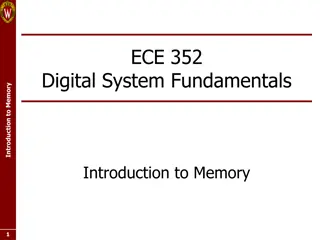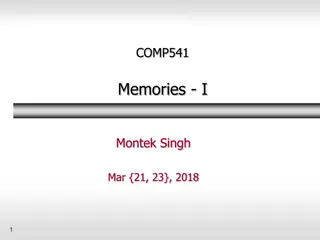
Memory Management: Concepts and Implementation in Operating Systems
Explore memory management concepts such as memory partitioning, paging, segmentation, and the implementation of page tables in operating systems. Learn about memory protection, shared pages, and more.
Download Presentation

Please find below an Image/Link to download the presentation.
The content on the website is provided AS IS for your information and personal use only. It may not be sold, licensed, or shared on other websites without obtaining consent from the author. If you encounter any issues during the download, it is possible that the publisher has removed the file from their server.
You are allowed to download the files provided on this website for personal or commercial use, subject to the condition that they are used lawfully. All files are the property of their respective owners.
The content on the website is provided AS IS for your information and personal use only. It may not be sold, licensed, or shared on other websites without obtaining consent from the author.
E N D
Presentation Transcript
This work is licensed under a Creative Commons Attribution-ShareAlike 4.0 International License. This presentation is released under Creative Commons- A6ribute,on 4.0 License. You are free to use, distribute and modify it , including for commercial purposes, provided you acknowledge the source.
Module 4: Memory Management Topic Memory Concept CS-2013 (Operating System) Part VI Lecture -25
Topic to be Cover Introduction and Background of Memory Management Memory Partitioning Single Absolute Partitions. Single Relocatable Partitions. Multiple Partitions. Multiple Fixed Partitions(MFP). Multiple Variable Partitions(MVP). Swapping Contiguous Allocation Best-Fit, First-Fit, Worst Fit, Paging Segmentation Segmentation with Paging. Numerical examples.
Implementation of Page Table Each operating system has its own methods for storing page tables. Most allocate a page table for each process. A pointer to the page table is stored with the other register values (like the instruction counter) in the process control block. When the dispatcher is told to start a process, it must reload the user registers and define the correct hardware page-table values from the stored user page table. Operating system, Harish Tiwari, SPSU, Udaipur 4
Implementation of Page Table ( (Memory Protection) Memory Protection) Memory protection implemented by associating protection bit with each frame. Valid-invalid bit attached to each entry in the page table: valid indicates that the associated page is in the process logical address space and is thus a legal page. invalid indicates that the page is not in the process logical address space. Operating system, Harish Tiwari, SPSU, Udaipur 5
Implementation of Page Table ( (Memory Protection) Memory Protection) Valid (v) or Invalid (i) Bit In A Page Table 6
Implementation of Page Table ( (Shared pages) Shared pages) An advantage of paging is the possibility of sharing common code. Reentrant code (or pure code) it can be shared. It is non-self-modifying code ( it never changes during execution). Multiple processes can execute the same code at the same time. Each process has its own copy of registers and data storage ( data for different processes will , be different. Shared code One copy of read-only (reentrant) code shared among processes (i.e., text editors, compilers, window systems). Shared code must appear in same location in the logical address space of all processes. Private code and data Each process keeps a separate copy of the code and data. The pages for the private code and data can appear anywhere in the logical address space.
Implementation of Page Table ( (Shared pages Shared pages Example) Example) Operating system, Harish Tiwari, SPSU, Udaipur 17
Implementation of Page Table ( (Shared pages) Shared pages) Heavily used programs can also be shared( code must be reentrant): Compilers. Window systems. Run-time libraries. Database systems etc. The sharing of memory among processes is like the sharing of the address space of a task by threads. Operating system, Harish Tiwari, SPSU, Udaipur 18
Segmentation Memory-management scheme that supports user view of memory. A program is a collection of segments. A segment is a logical unit such as: main program, procedure, function, method, object, local variables, global variables, common block, stack, symbol table, arrays Operating system, Harish Tiwari, SPSU, Udaipur 20
Users View of a Program Operating system, Harish Tiwari, SPSU, Udaipur 21
Logical View of Segmentation 1 4 1 2 3 2 4 3 user space physical memory space Operating system, Harish Tiwari, SPSU, Udaipur 22
Segmentation Architecture Logical address consists of a two tuple: <segment-number, offset>, Segment table maps two-dimensional physical addresses; each table entry has: base contains the starting physical address where the segments reside in memory. limit specifies the length of the segment. Segment-table base register (STBR)points to the segment table s location in memory. Segment-table length register (STLR) indicates number of segments used by a program; segment number s is legal if s < STLR. Operating system, Harish Tiwari, SPSU, Udaipur 23
Segmentation Architecture (Cont.) Relocation. dynamic by segment table Sharing. shared segments same segment number Allocation. first fit/best fit external fragmentation Operating system, Harish Tiwari, SPSU, Udaipur 24
Segmentation Architecture (Cont.) Protection. With each entry in segment table associate: validation bit = 0 illegal segment read/write/execute privileges Protection bits associated with segments; code sharing occurs at segment level. Since segments vary in length, memory allocation is a dynamic storage-allocation problem. A segmentation example is shown in the following diagram Operating system, Harish Tiwari, SPSU, Udaipur 25
Segmentation Hardware Operating system, Harish Tiwari, SPSU, Udaipur 26
Example of Segmentation Operating system, Harish Tiwari, SPSU, Udaipur 27
Sharing of Segments Operating system, Harish Tiwari, SPSU, Udaipur 28
Segmentation with Paging MULTICS The MULTICS system solved problems of external fragmentation and lengthy search times by paging the segments. Solution differs from pure segmentation in that the segment-table entry contains not the base address of the segment, but rather the base address of a page table for this segment. Operating system, Harish Tiwari, SPSU, Udaipur 29
MULTICS Address Translation Scheme Operating system, Harish Tiwari, SPSU, Udaipur 30
Segmentation with Paging Segmentation and paging can be combined to provide Efficiency of paging scheme Protection and sharing capability of the of segmentation with simple segmentation the logical address space contains- segment Number and offset. When paging is added the segment offset is further divided into page number and page offset. The segment table entry contains the address of the segment s page table. The hardware adds the logical address s page number bits to the page table address to locate the page table entry. The final physical address is formed by appending the page offset to the page frame number, specified in the page table entry. Operating system, Harish Tiwari, SPSU, Udaipur 31
Segmentation with Paging Logical Address S P D + + Pf Pf D Segment Table Address Physical Address Segment Table Page Table Operating system, Harish Tiwari, SPSU, Udaipur 32
Numericals Question 1 : Why the page sizes always power of 2 ? Answer : All addresses are binary and are divided into page or, page frame and offset. By making the page size a power of 2, the page number, page frame number and the offset can be determined by looking at particular bits in the address; no mathematical calculation is required. Operating system, Harish Tiwari, SPSU, Udaipur 33
Question 2: Answer: On a simple paging scheme with following parameters: physical memory No of pages in logical address space - page size How many bits are in the logical address space. 224 bytes. 256 pages. 210 bytes. - - to find out the total bits in logical address space, we need to find out the total logical address space. Total Logical address space is so an 18 bit address is required to cover 218 bytes address space = No of pages*size of each page. = 256 x 210 = 28 x 210 = 218 Operating system, Harish Tiwari, SPSU, Udaipur 34
Question 3: On a simple paging scheme with following parameters: physical memory No of pages in logical address space - page size How many bits in the logical address space used for the page number and offset. 224 bytes. 256 pages. 210 bytes. - - Answer: total logical address space Size of the one page is - - 218 bytes ( 2M ) 210 bytes ( 2N ) so the no of bits for Page number so the no of bits for offset = = = = (M-N) bits 18-10 8 bits(no of pages) N bits 10 bits Operating system, Harish Tiwari, SPSU, Udaipur 35
Question 4 : On a simple paging scheme with following parameters: physical memory No of pages in logical address space - page size How many bytes are in the page frame.. 224 bytes. 256 pages. 210 bytes. - - Answer: the page frame size is same as the page size. Since page size is 210 so the frame size is also 210 Operating system, Harish Tiwari, SPSU, Udaipur 36
Question 5 : On a simple paging scheme with following parameters: physical memory No of pages in logical address space page size How many bits in the physical address is specify the page frame. 224 bytes. 256 pages. 210 bytes. - - - Answer: 24 bit address is required to cover 224 bytes physical address. page size and the frame size is same so last 10 bits out of 24 of the physical address is used as offset bits. Remaining 14 bits specifies the page frame number. Operating system, Harish Tiwari, SPSU, Udaipur 37
Question 6 : On a simple paging scheme with following parameters: physical memory No of pages in logical address space - page size How many entries are in the page table? 224 bytes. 256 pages. 210 bytes. - - Answer: since there are 256 pages in the logical address space. So the page table must be 256 entries long. Operating system, Harish Tiwari, SPSU, Udaipur 38
When page table parameters given. Question 7 : On a simple paging scheme with following parameters: page Table entries length of page table entry page size How many bits in the logical address specifies the page number and offset and how many bits are in the logical address? - -16 bits(including valid/invalid bit). - 1024 bytes. 512 entries. Answer: we know that total number of pages are so we need to refer 512 pages so we need 9 bits to specify the page number. - - 512 pages 29 offset bits So 10 bits are used to specify the offset. so total bits in the logical address is 19. = size of the page = 1024 Bytes = 210 Operating system, Harish Tiwari, SPSU, Udaipur 39
Question 8 : valid/invalid bit). page size what is the size of the logical address space.? On a simple paging scheme with following parameters: page Table entries - length of page table entry -16 bits(including 512 entries. - 1024 bytes. Answer: 9 bits to specify the page number. 10 bits are used to specify the offset. bits in the logical address is 19. so the total logical address space= 219 bytes. Operating system, Harish Tiwari, SPSU, Udaipur 40
Question 9 : On a simple paging scheme with following parameters: page Table entries length of page table entry page size how many bits in the physical address specify the page frame numbers and offset and also find out the total physical address space? - -16 bits(including valid/invalid bit). - 1024 bytes. 512 entries. Answer: each entry in the page table is 16 bit long( including the 1 bit valid/ invalid bit. So 15 bit is the physical address is used to specify the frame number. offset is same in the logical address and physical address so number of bits in the physical address specifies the offset is 10. Total number of bits in the physical address-15+10=25 bits. Total physical address space is = 225 bytes. Operating system, Harish Tiwari, SPSU, Udaipur 41
Unsolved Questions 1. What are the two major difference between segmentation and paging? 2. Clearly distinguish between the physical address space and logical address space of a process? 3. What is the effect of allowing two entries in a page table to point to the same frame in the memory? 4. On simple paged system, can the logical address space be larger than the physical address space? 5. Why paging is faster than segmentation? 6. Explain the difference between internal and external fragmentation. 7. What is the advantages of combining the segmentation and paging scheme into one scheme? 8. What do you understand by dynamic linking and dynamic loading.? Operating system, Harish Tiwari, SPSU, Udaipur 43






















